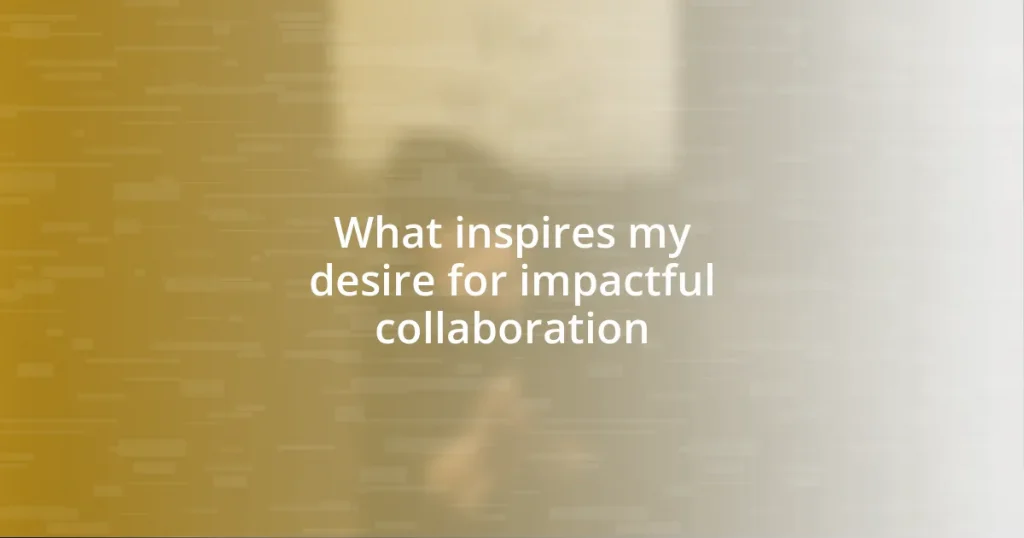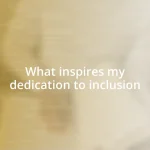Key takeaways:
- Impactful collaboration thrives on trust, open communication, and shared vision, fostering creativity and accountability.
- Effective teamwork requires clear role distribution, regular communication, and establishing trust among members.
- Overcoming collaboration challenges can be achieved through emotional intelligence, visual aids, and finding common ground in work styles.
- Measuring success in collaboration involves both qualitative insights and quantitative metrics, as well as celebrating failures for growth opportunities.

Understanding impactful collaboration
Impactful collaboration is more than just working together; it’s about connecting on deeper levels and leveraging the strengths of each participant. I often find myself reflecting on past projects where the synergy created through genuine dialogue led to unexpected innovations. Have you ever experienced that exhilarating moment when different perspectives meld together to create something greater than the sum of its parts?
To me, this type of collaboration thrives on trust and open communication. I remember a team I was part of where we didn’t just share tasks; we shared ideas, concerns, and even vulnerabilities. It really struck a chord with me when one teammate confessed their fears about a project, and rather than dismissing it, we all rallied around to support and brainstorm solutions. This experience taught me that the willingness to be vulnerable can lead to breakthroughs that a strictly transactional approach could never achieve.
I’ve seen organizations succeed or fail based on how they approach collaboration. If everyone is just ticking boxes, are we really collaborating? I believe impactful collaboration not only respects individual contributions but also nurtures them in a way that fosters creativity and accountability. When everyone feels valued and heard, the results can be transformative and inspiring.
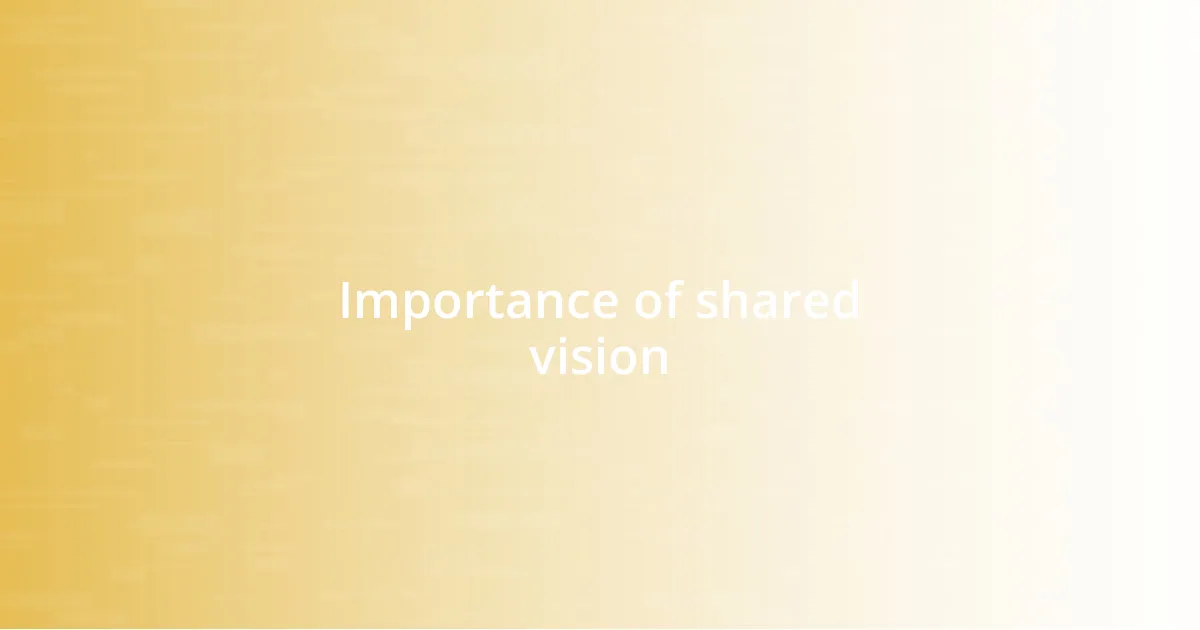
Importance of shared vision
A shared vision acts like a compass, guiding everyone involved towards a common goal. I’ve been in collaborative settings where differing objectives created chaos, undermining the potential for success. In contrast, when a group aligns on a clear vision, it energizes the team, infusing our work with purpose and direction. I recall a project where we crafted a vivid, collective vision statement together, and it was almost magical to witness how that clarity unified our efforts, turning potential conflicts into opportunities for collaboration.
- Elevates team morale, fostering a sense of belonging.
- Encourages creative problem-solving through a united approach.
- Helps individuals prioritize tasks that align with the overarching goal.
- Strengthens commitment, as everyone feels they’re part of something larger than themselves.
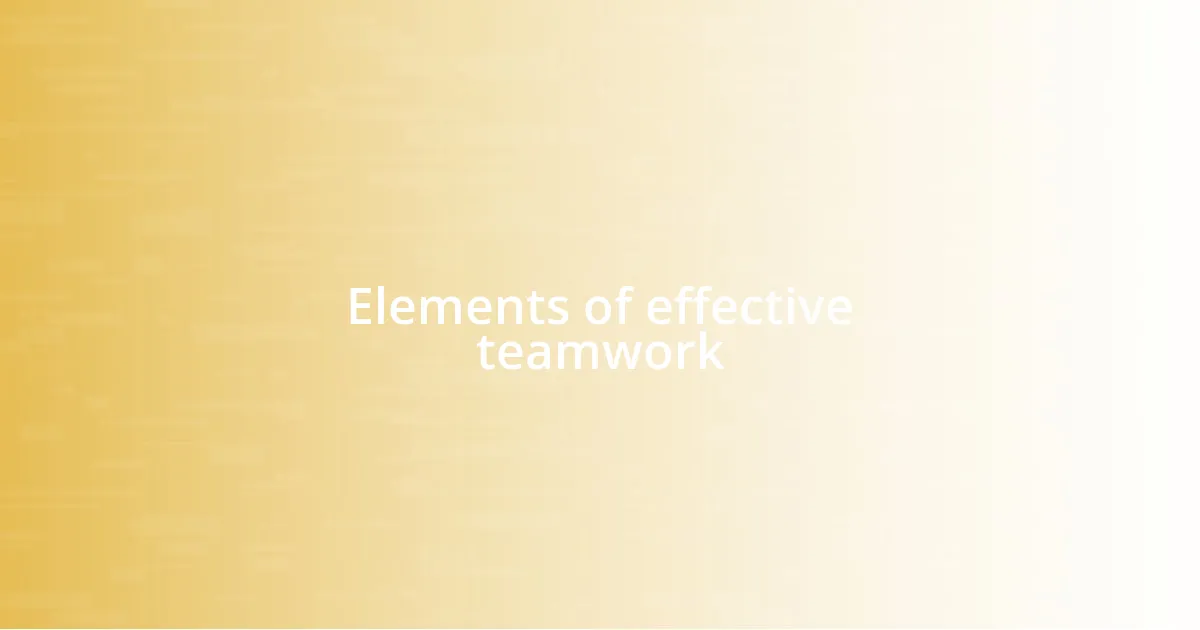
Elements of effective teamwork
Effective teamwork hinges on several key elements that enhance collaboration. One of the most crucial aspects is communication. I remember a project where my team held regular check-ins to discuss not only our tasks but also our thoughts and feelings about the work. This openness not only kept everyone informed but also fostered a sense of belonging and support. Have you noticed how sharing our concerns can strengthen team bonds?
Another fundamental element is the distribution of roles and responsibilities. In my experience, teams that clearly define who is responsible for what tend to operate more smoothly. For instance, during a product launch, our team assigned specific tasks based on each member’s strengths. This clarity not only minimized confusion but also empowered us to take ownership of our individual responsibilities, leading to a seamless collaboration.
Trust also plays an instrumental role in effective teamwork. I once worked with a group that established a ‘trust agreement,’ where we committed to supporting each other’s ideas and providing constructive feedback. This practice helped create a safe space where everyone felt comfortable sharing wild ideas without fear of judgment. After all, wouldn’t we all benefit from a little more trust in our collaborative efforts?
| Element | Description |
|---|---|
| Communication | Open and honest dialogue fosters connection and keeps everyone aligned. |
| Defined Roles | Clear responsibilities empower team members and enhance accountability. |
| Trust | A supportive environment encourages sharing of ideas and constructive feedback. |
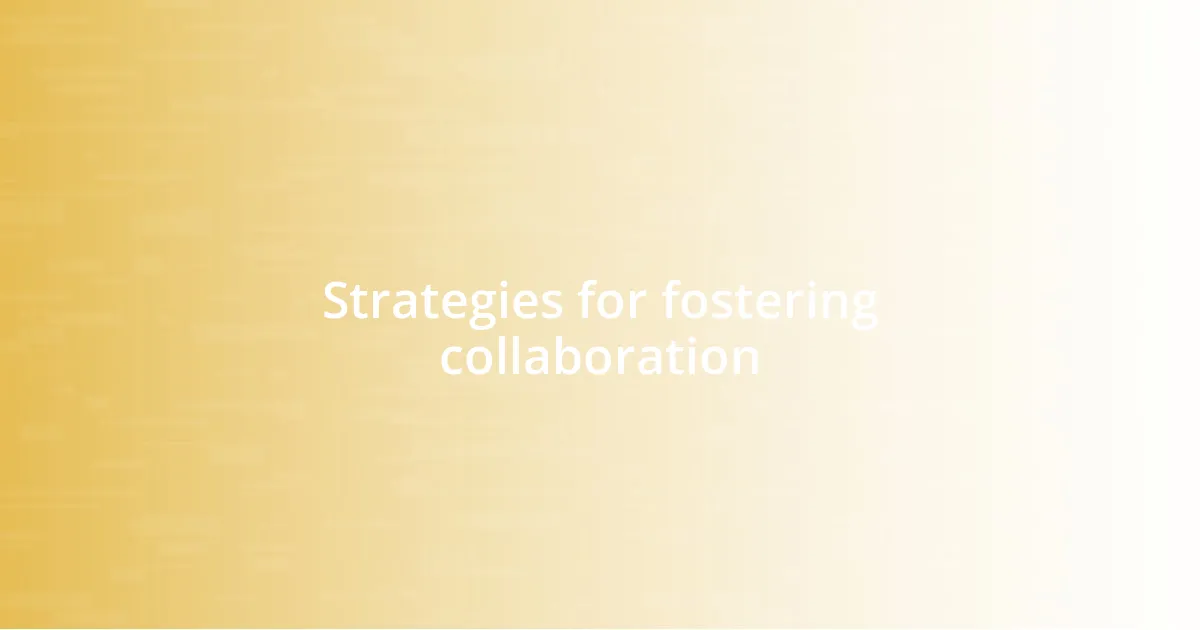
Strategies for fostering collaboration
Fostering collaboration is all about creating an atmosphere where ideas can flourish. I vividly recall a workshop I attended that was designed to break down silos within teams. We engaged in activities that encouraged us to share personal stories related to our work. It was fascinating to see how these narratives not only enhanced understanding but also deepened our connections. Isn’t it amazing how sharing little pieces of ourselves can invite others in and spark collaborative energy?
Another strategy that’s proven effective for me is encouraging diverse viewpoints. During a brainstorming session, I remember advocating for a “no bad idea” rule. This single shift in mindset transformed the atmosphere; individuals who might have held back began to contribute freely. One team member’s unconventional idea about using gamification in our project led us down an innovative path we hadn’t considered before. Have you ever experienced a moment when an unexpected perspective opened up new possibilities?
Lastly, building rituals around collaboration can be tremendously beneficial. In a previous role, our team established a weekly “celebration of wins” meeting, where we collectively acknowledged our efforts, big or small. This not only boosted morale but also reinforced our interconnectedness as we celebrated each other’s contributions. I genuinely believe that when teams take time to appreciate their milestones, even the smallest victories, it fosters a sense of community. What rituals have you found effective in cultivating a collaborative spirit?
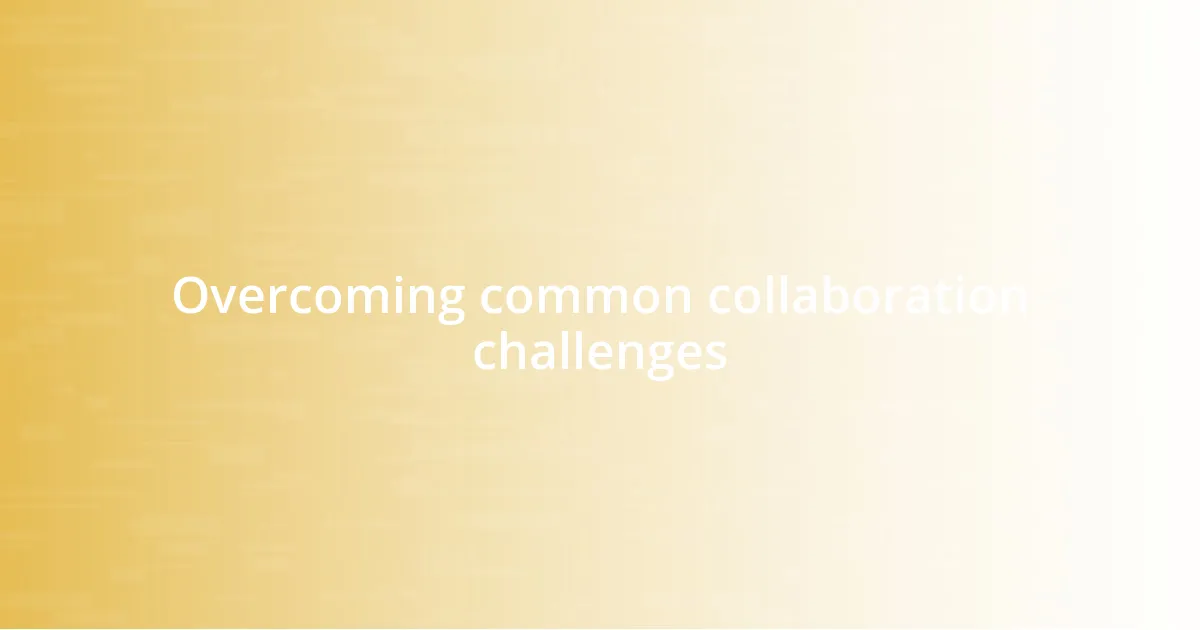
Overcoming common collaboration challenges
Navigating collaboration difficulties is something I’ve faced numerous times. For instance, in a project that seemed plagued by miscommunication, we took a step back and decided to chart out our ideas visually. Using tools like mind mapping not only clarified our thoughts but also sparked lively discussions. Did you realize how visuals can bridge gaps in understanding?
Another common hurdle is balancing differing work styles. I remember working with a colleague who preferred a structured approach while I thrived in spontaneity. To find a middle ground, we established a framework that combined both styles—setting deadlines and allowing room for creativity. This compromise not only eased our tensions but also led to a more dynamic working relationship. How have you managed to sync with diverse work habits within your team?
I’ve also discovered that emotional intelligence can be a powerful ally in overcoming collaboration challenges. In a tense negotiation, I sensed the unease among team members and decided to pause the discussion. Instead, I encouraged everyone to share their feelings about the project. By voicing our apprehensions, we not only identified the root causes of our conflict but also developed deeper empathy for each other. Have you ever found that opening up emotionally can diffuse a potentially volatile situation?
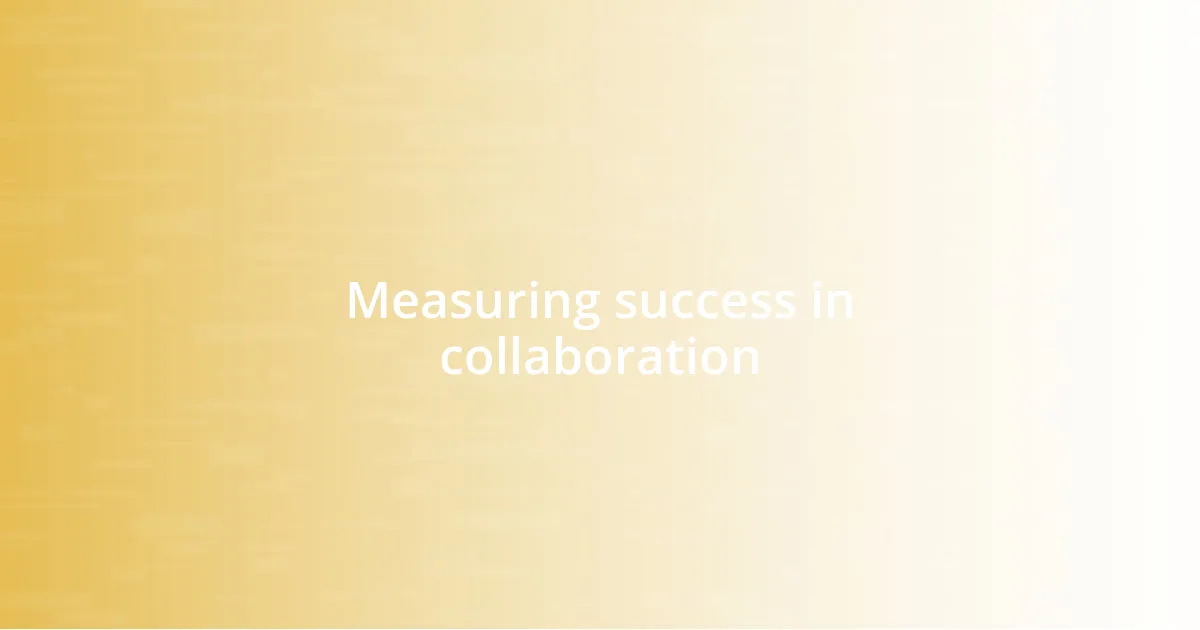
Measuring success in collaboration
Measuring success in collaboration can often be as nuanced as the collaboration itself. In a project I led, we established clear benchmarks, like increased engagement and the speed of decision-making. After each phase, I would gather feedback from the team on how well we communicated and collaborated. It was intriguing to see how metrics could elevate our conversations, transforming subjective feelings into tangible data. Have you ever quantified something that felt purely qualitative?
I also learned that success isn’t solely about reaching goals but understanding the journey. During a collaborative initiative, my team embraced regular check-ins to assess not just what we achieved, but how we felt throughout the process. Those discussions uncovered underlying tensions and sparked insights that propelled our project forward in unexpected ways. Isn’t it fascinating how a simple conversation can redefine success?
Lastly, I’ve found that celebrating failures is a crucial aspect of measuring collaborative success. I recall a time when an initiative didn’t pan out as expected. Instead of shying away from it, we turned that moment into a case study during our next meeting. Analyzing what went wrong together deepened our understanding and solidarity. How many teams can share and learn from their missteps, turning potential setbacks into growth opportunities?










